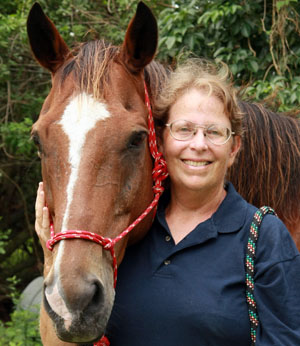TAILS FROM THE TRAILS
Life imitates art, or vice versa.
The other day, I was driving home when, just as I got to a four-way intersection — thankfully, also a four-way stop — I glanced left and saw a horse flying toward me. The bay had no rider, no saddle, only a halter with a lead line fashioned into reins. It blew through the intersection at a run, then slowed and circled back, obviously wanting to get into one of the properties on the corner.
I parked my car crosswise in the middle of the road and went about trying to catch the horse, which kept running past me. The owner showed up, an older teen, barefoot, in shorts, sporting a soon-to-be-colorful bruise on the back of her right thigh. She had been trail riding and fallen when the horse spooked.
The other drivers waited patiently, and finally I grabbed the lead rope as the horse trotted past. I handed the horse back to the owner, who was spitting mad — at the horse. She had no idea how lucky she had been that neither she nor her horse had ended up severely injured or dead.
I also recall a horrific accident on B Road a few years back. A rider was riding along just as a vehicle passed. The rider urged the horse over to the side of the road, but it had rained recently and there were large puddles. The horse, instead of moving over, shied back into the road and was struck by the vehicle. It lost a leg and its life.
All of this was in my mind when I recently read a thread on the Wellington-WEF message board (www.wellington-wef.com) exhorting riders to ride with more awareness and drivers to slow and use caution. It was started by Jacquie McCutchan. I met up with her at On Course Consignment Shop in Wellington, which she owns and runs.
“My barn faces Forest Hill Blvd.,” she explained. “One day, I saw a girl riding past on the grassy shoulder, obviously on her way to a show, dressed properly, a number on her saddle pad. The horse was walking. As they got to the corner of Forest Hill and South Shore, this crazy guy on a motorcycle went flying by, going about 90 miles an hour.”
The horse spun around, and the rider fell off. “Luckily, the horse didn’t take off. The rider, who didn’t appear to be hurt, remounted and continued on,” McCutchan recalled. “That’s when I posted on the WEF board, to vent a little. This is show season, after all, and there are a lot of horses out and about. Riders and drivers all need to be aware of each other and take sensible precautions. Some drivers appear to be either dumb or ignorant. They should know to slow down and move over, especially if they’re driving something big and noisy on a bumpy dirt road. Horses react fast and unpredictably.”
Distracted driving is also a problem, she said.
“Then there are the riders who seem to think they’re the only ones on the road,” McCutchan said. “They ride along while talking on phones, and cross streets without a thought given to any oncoming traffic. Even in marked horse crossings, they have to watch for distracted or belligerent drivers. Not everyone behind the wheel is horse-savvy.”
Palm Beach County Sheriff’s Office Deputy Eric Davis warned riders to always be on the lookout for cars.
“Although horses are considered the same as pedestrians, cars have the right of way on a road,” Davis said. “There are no laws governing who can ride on the road, but riders 16 and under must wear helmets. If it’s dusk or dawn, wear reflective clothing. Riders should know their horses. If they’re easily spooked, they shouldn’t be riding on roads. But any horse can react to something unexpected, like a car horn, backfire or a blowing plastic bag. You can’t think, ‘That wouldn’t happen to me.’ It could.”
Then there’s the issue of a loose horse on the road. A few weeks back, my neighbor, who drives to work quite early, around 2 a.m., found three horses wandering on the road. She tried calling 911 for help, but no one responded. She finally herded them into a nearby fenced property, but was utterly frustrated by the lack of response.
“We’re not really trained in horse capture,” Davis said. “Horses loose in a rural horse community are not the same as a horse loose on a busy highway, where we’d block the road and call Animal Care and Control (AC&C), who are better suited to deal with this type of problem.”
AC&C’s Capt. David Walesky said there are several reasons horses get loose.
“It could be a rider got dumped and the horse ran off, or could be the horse escaped from its enclosure,” he said. “I’ve seen some very lax confinement fences. AC&C is not an emergency response agency. We don’t have lights or sirens on our vehicles, but we try to get there as soon as possible. If the owner knows the horse is out, it’s usually caught by the time we’d get there. We do have a horse trailer, but it takes time to hitch it up and drive to the site.”
Walesky also advised riders to use caution when riding on roads. “Dress appropriately and use proper equipment,” he said. “Use caution. Horses can spook into traffic, and in a confrontation between a car and a horse, the car is always going to win.”
“I hope that both riders and drivers will be more aware of each other and proceed more cautiously,” McCutchan said. “Let’s get some education out there. Horses and cars don’t mix.”
If you see a horse loose on the road, call the PBSO’s non-emergency line at (561) 688-3000 or AC&C at (561) 233-1200.









Another Great Article Ellen, I especially like this one !!!